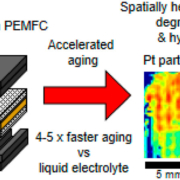Work on an industrially-sized PEM fuel cell published
Finden scientists Dr Antony Vamvakeros and Dr Simon Jacques have collaborated with collaborated with a big team from multiple institutions including ESRF, Université Grenoble Alpes and University of British Columbia to investigate an industrially-relevant PEM fuel cell using diffraction tomography. You can see the paper, entitled “Imaging Heterogeneous Electrocatalyst Stability and Decoupling Degradation Mechanisms in Operating Hydrogen Fuel Cells”, published at ACS Energy Letters here: https://pubs.acs.org/doi/10.
The proliferation of hydrogen fuel cell systems is hindered by a degradation of the platinum catalyst. Here, we provide a device-level assessment of the catalyst degradation phenomena and its coupling to nanoscale hydration gradients, using advanced operando X-ray scattering tomography tailored for device-scale imaging. Gradients formed inside the fuel cell produce a heterogeneous degradation of the catalyst nanostructure, which can be linked to the flow field design and water distribution in the cell. Striking differences in catalyst degradation are observed between operating fuel cell devices and the liquid cell routinely used for catalyst stability studies, highlighting the crucial impact of the complex operating environment on the catalyst degradation phenomena. This degradation knowledge gap accentuates the necessity of multimodal, in situ characterization of real devices when assessing the performance and durability of electrocatalysts and, more generally, electrochemically active phases used in energy conversion and storage technologies.
Read the full article at https://doi.org/10.1021/acsenergylett.1c00718

